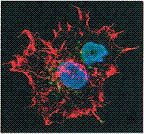Biochemistry, Department of

Gautam Sarath Publications
Document Type
Article
Date of this Version
1-1-2004
Abstract
RATIONALE: Proteomic technology has been shown to have distinct advantages for allergen characterization and identification. Therefore, we have used 2-D electrophoresis and protein microarrays to characterize the profile of allergens and assess their level in lentils.
METHODS: Lentil varieties were extracted and centrifuged to obtain 2S, 7S and 11S fractions. The profile of IgE-binding proteins in these fractions was assessed using lentil-allergic sera, by immunoblotting of 2-D electrophoretic separations. The level of IgE-binding was also assessed using protein microarrays. Arrays of covalently attached proteins were first incubated with lentil-allergic sera, followed by incubation with fluorescently- labeled anti-IgE detection antibody. Laser-induced fluorescence was used to detect IgE-binding.
RESULTS: Immunoblotting of electrophoretic separations showed several regions of IgE-binding that were consistently observed for all varieties. Major IgE-binding was observed for isoforms of 31 and 48 kDa spots. These proteins are of particular interest because of their low abundance, but high IgE-binding. Comparatively less IgE-binding was found for 12 and 14 kDa spots. Microarray analysis showed that IgE-binding of the 11S fraction was significantly greater than all other fractions. Microarrays enabled quantitative assessment of IgE-binding.
CONCLUSIONS: The application of proteomic technologies resulted in characterization of IgE-binding protein profile and determination of their level in lentils. Microarrays represent a promising tool for allergen investigation, detection and diagnosis.


Comments
Published in J ALLERGY CLIN IMMUNOL VOLUME 113, NUMBER 2.